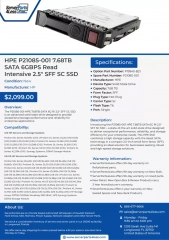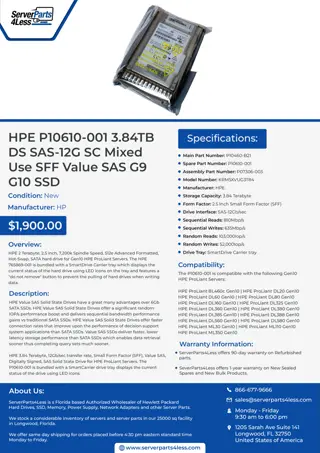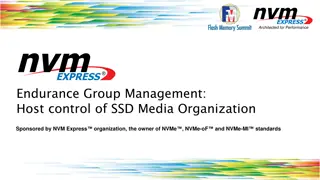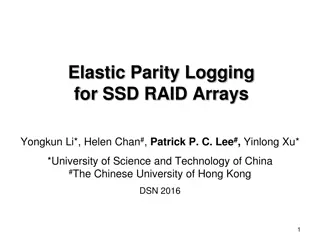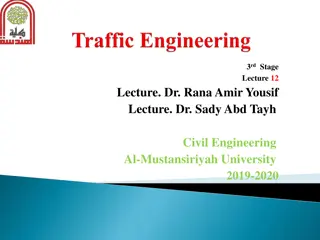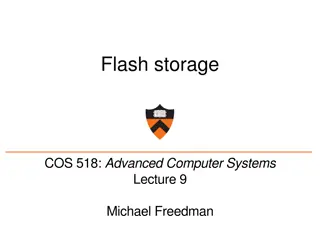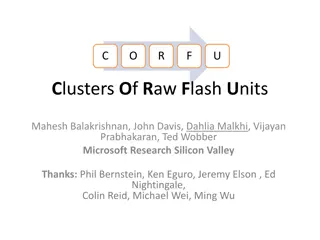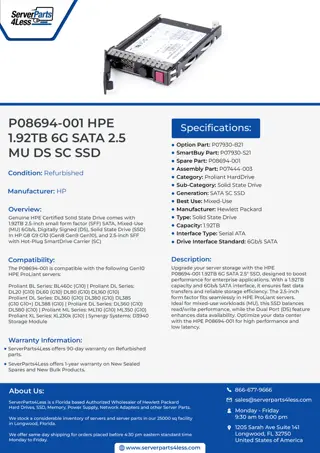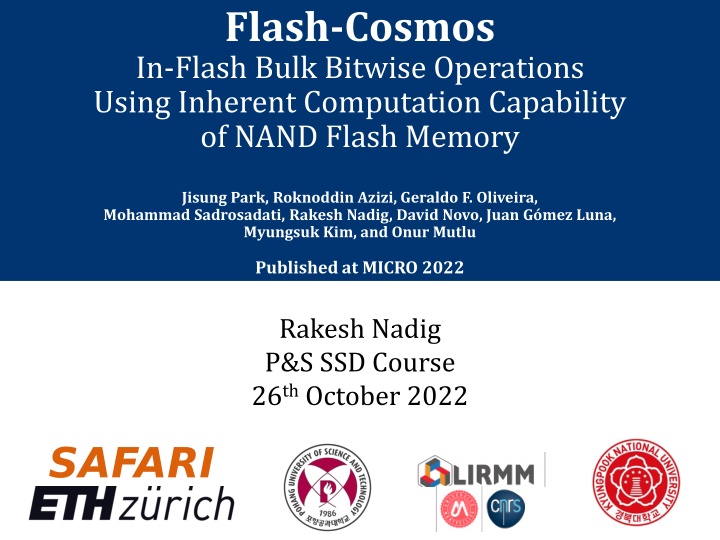
Flash-Cosmos: Enhancing Bulk Bitwise Operations Using NAND Flash Memory
Explore how Flash-Cosmos revolutionizes bulk bitwise operations by improving performance, energy efficiency, and reliability through innovative in-flash processing techniques. Discover the key ideas, results, and benefits of this groundbreaking technology for data-intensive applications.
Download Presentation

Please find below an Image/Link to download the presentation.
The content on the website is provided AS IS for your information and personal use only. It may not be sold, licensed, or shared on other websites without obtaining consent from the author. If you encounter any issues during the download, it is possible that the publisher has removed the file from their server.
You are allowed to download the files provided on this website for personal or commercial use, subject to the condition that they are used lawfully. All files are the property of their respective owners.
The content on the website is provided AS IS for your information and personal use only. It may not be sold, licensed, or shared on other websites without obtaining consent from the author.
E N D
Presentation Transcript
Flash-Cosmos In-Flash Bulk Bitwise Operations Using Inherent Computation Capability of NAND Flash Memory Jisung Park, Roknoddin Azizi, Geraldo F. Oliveira, Mohammad Sadrosadati, Rakesh Nadig, David Novo, Juan G mez Luna, Myungsuk Kim, and Onur Mutlu Published at MICRO 2022 Rakesh Nadig P&S SSD Course 26th October 2022
Executive Summary Background: Bulk bitwise operations are widely used in many important data-intensive applications, e.g., databases, graph processing, cryptography etc. Problem: Performance and energy efficiency of bulk bitwise operations are bottlenecked by 1) data movement between storage and the compute unit in traditional systems 2) data sensing (serial reading of operands) in prior in-flash processing (IFP) techniques Prior IFP techniques provide low reliability during computation Goal: Improve performance, energy efficiency and reliability of bulk bitwise operations in in-flash processing Key Idea: Flash-Cosmos (Flash-Computation with One-Shot Multi-Operand Sensing) is an in-flash processing technique that improves performance, energy efficiency and reliability of bulk bitwise operations using two key techniques: Multi-Wordline Sensing (MWS): Enables multi-operand bulk bitwise operations with a single sensing (read) operation Enhanced SLC-mode Programming (ESP): Increases the voltage margin between the erased and programmed states to provide higher reliability during in-flash computation Key Results: Flash-Cosmos is evaluated using 160 real 3D NAND flash chips and three real-world workloads Flash-Cosmos improves the performance and energy efficiency by 3.5x and 3.3x over state-of-the-art IFP technique while providing high reliability during computation 1
Talk Outline Motivation Background Flash-Cosmos Evaluation Summary 2
Bulk Bitwise Operations ... Databases Hyper-dimensional Computing Web Search Bulk Bitwise Operations Cryptography Genome Analysis Set Operations Graph Processing 3
Bulk Bitwise Operations Databases (database queries and indexing) ... Hyper-dimensional Computing Web Search Data movement between compute units Bulk Bitwise Operations Cryptography and the memory hierarchy significantly affects the performance of bulk bitwise operations Genome Analysis Set Operations Graph Processing 4
Data-Movement Bottleneck Conventional systems perform outside-storage processing (OSP) after moving the data to host CPU through the memory hierarchy Computation Read Read Host Main Memory Storage Processor (CPU, GPU) Write Write Memory Bandwidth tens to hundreds of GB/s Storage I/O Bandwidth ~ 8 GB/s Data Movement Bottleneck The external I/O bandwidth of storage is the main bottleneck for data movement in OSP 5
NDP for Bulk Bitwise Operations Cache Our focus Large data sets that do not fit in main memory (e.g., Compute Cache1) ... DRAM-based main memory (e.g., Ambit2) Near-Data Processing In-Flash (e.g., ParaBit5) NVM-based main memory (e.g., Pinatubo3) In-Storage (e.g., Biscuit4) [1] Aga+, Compute Caches," HPCA, 2017 [2] Seshadri+, Ambit: In-Memory Accelerator for Bulk Bitwise Operations Using Commodity DRAM Technology, MICRO, 2017 [3] Li+, Pinatubo: A Processing-in-Memory Architecture for Bulk Bitwise Operations in Emerging Non-Volatile Memories, DAC, 2016 [4] Gu+, Biscuit: A Framework for Near-Data Processing of Big Data Workloads, ISCA, 2016 [5] Gao+, ParaBit: Processing Parallel Bitwise Operations in NAND Flash Memory Based SSDs, MICRO, 2021 6
In-Storage Processing (ISP) ISP performs computation using an in-storage computation unit ISP reduces external data movement by transferring only the computation results to the host Read In-Storage Computation Unit NAND Chip #4 NAND Chip #1 Host Read Read Main Memory Processor (CPU, GPU) Write Computation Write Write NAND Chip #4 NAND Chip #1 Storage Storage External I/O Bandwidth ~ 8 GB/s Memory Bandwidth tens to hundreds of GB/s Storage Internal I/O Bandwidth ~ 9.6 GB/s Data Movement Bottleneck 7
In-Storage Processing (ISP) ISP performs computation using the in-storage computation unit ISP reduces external data movement by transferring only the computation results to the host Read Storage internal I/O bandwidth is the main bottleneck for data movement in ISP In-Storage Computation Unit NAND Chip #4 NAND Chip #1 Read Read Main Memory Processor (CPU, GPU) Write Write Write NAND Chip #4 NAND Chip #1 Storage Storage External I/O Bandwidth ~ 8 GB/s Memory Bandwidth tens to hundreds of GB/s Storage Internal I/O Bandwidth ~ 9.6 GB/s Data Movement Bottleneck 8
In-Flash Processing (IFP) IFP performs computation within the flash chips as the data operands are being read serially IFP reduces the internal data movement bottleneck in storage by transferring only the computation results to the in-storage computation unit Read In-Storage Computation Unit NAND Chip #4 NAND Chip #1 Write Computation Host Read Read Main Memory Processor (CPU, GPU) Write Write NAND Chip #4 NAND Chip #1 Storage Storage External I/O Bandwidth ~ 8 GB/s Memory Bandwidth tens to hundreds of GB/s Storage Internal I/O Bandwidth ~ 9.6 GB/s Data Sensing Bottleneck 9
In-Flash Processing (IFP) IFP performs computation within the flash chips as the data operands are being read serially IFP reduces the internal data movement bottleneck in storage by transferring only the computation results to the in-storage computation unit Read In-Storage Computation Unit NAND Chip #4 Host IFP fundamentally mitigates the data movement NAND Chip #1 Write Computation Read Read Main Memory Processor (CPU, GPU) Write Write NAND Chip #4 NAND Chip #1 Storage Storage External I/O Bandwidth ~ 8 GB/s Memory Bandwidth tens to hundreds of GB/s Storage Internal I/O Bandwidth ~ 9.6 GB/s Data Sensing Bottleneck 10
Data Sensing Bottleneck in IFP State-of-the-art IFP technique [1] performs bulk bitwise operations by controlling the latching circuit of the page buffer NAND Flash Chip Operand A Operand B Operand C Operand D In-Storage Computation Unit NAND Chip #4 NAND Chip #1 A NAND Chip #4 NAND Chip #1 Page Buffer 11 [1] Gao+, ParaBit: Processing Parallel Bitwise Operations in NAND Flash Memory Based SSDs, MICRO, 2021
Data Sensing Bottleneck in IFP State-of-the-art IFP technique [1] performs bulk bitwise operations by controlling the latching circuit of the page buffer NAND Flash Chip A B C D A Data Sensing A A Page Buffer 12
Data Sensing Bottleneck in IFP State-of-the-art IFP technique [1] performs bulk bitwise operations by controlling the latching circuit of the page buffer NAND Flash Chip A B C D B Data Sensing A ANDB A A Page Buffer 13
Data Sensing Bottleneck in IFP State-of-the-art IFP technique [1] performs bulk bitwise operations by controlling the latching circuit of the page buffer NAND Flash Chip A B C D C Data Sensing A ANDB A ANDB AND C Page Buffer 14
Data Sensing Bottleneck in IFP State-of-the-art IFP technique [1] performs bulk bitwise operations by controlling the latching circuit of the page buffer NAND Flash Chip A B C D Serial data sensing is the bottleneck in prior in-flash processing techniques C Data Sensing A ANDB A ANDB AND C Page Buffer 15
Reliability Issues in IFP Prior IFP approaches cannot leverage ECC and data-randomization techniques as computation is performed within the flash chips during data sensing NAND Flash Chip A B C D A Page Buffer 16
Reliability Issues in IFP Prior IFP approaches cannot leverage ECC and data-randomization techniques as computation is performed within the flash chips during data sensing NAND Flash Chip A B A B C D Data Sensing Page Buffer 17
Reliability Issues in IFP Prior IFP approaches cannot leverage ECC and data-randomization techniques as computation is performed within the flash chips during data sensing NAND Flash Chip A B B B C D Data Sensing A AND B A Page Buffer 18
Reliability Issues in IFP Prior IFP approaches cannot leverage ECC and data-randomization techniques as computation is performed within the flash chips during data sensing NAND Flash Chip A B B highly error-tolerant Prior IFP techniques requires the application to be B C D Data Sensing A AND B A Page Buffer 19
Our Goal Address the bottleneck of state-of-the-art IFP techniques (serial sensing of operands) Make IFP reliable (provide accurate computation results) 20
Our Proposal Flash-Cosmos enables Computation on multiple operands using a single sensing operation Provide high reliability during in-flash computation NAND Flash Chip A B C A B C D Data Sensing A AND B AND C Page Buffer 21
Talk Outline Motivation Background Flash-Cosmos Evaluation Summary 22
NAND Flash Basics: A Flash Cell A flash cell stores data by adjusting the amount of charge in the cell 1 0 Erased Cell (Low Charge Level) Programmed Cell (High Charge Level) Activation Operates as a resistor Operates as an open switch 23
NAND Flash Basics: A NAND String A set of flash cells are serially connected to form a NAND String Bitline (BL) 1 0 0 1 0 NAND String 24
NAND Flash Basics: Read Mechanism NAND flash memory reads data by checking the bitline current Bitline (BL) 1 0 0 Non-Target Cells: Operate as resistors regardless of stored data 1 0 NAND String 25
NAND Flash Basics: Read Mechanism NAND flash memory reads data by checking the bitline current Bitline (BL) Target Cells: Operate as resistors (1) or open switches (0) 1 0 0 Non-Target Cells: Operate as resistors regardless of stored data 1 0 NAND String 26
NAND Flash Basics: Read Mechanism NAND flash memory reads data by checking the bitline current BLi BLj Target Cells: Operate as resistors (1) or open switches (0) 1 0 0 1 Reads as 1 if BL current flows Reads as 0 if BL current cannot flow 0 1 Non-Target Cells: Operate as resistors regardless of stored data 1 0 0 1 NAND String 27
NAND Flash Basics: A NAND Flash Block NAND strings connected to different bitlines comprise a NAND block BL1 BL2 Block BL3 BL4 BL5 BLN 1 1 1 1 1 1 WL1 0 0 0 0 0 0 A single wordline (WL) controls a large number of flash cells: High bit-level parallelism WL2 0 0 0 0 0 0 WL3 1 1 1 1 1 1 WL4 0 0 0 0 0 0 WLM 28
NAND Flash Basics: Block Organization A large number of blocks share the same bitlines BL1 BL2 BL3 BL4 BL5 BLN Block1 Block2 BlockK 29
Similarity to Digital Logic Gates A large number of blocks share the same bitlines BL1 BL2 BL3 BL4 BL5 BLN Block1 Block2 Cells in the same block are connected serially: Similar to digital AND 2-input AND A B A B BlockK 30
Similarity to Digital Logic Gates A large number of blocks share the same bitlines. BL1 BL2 BL3 BL4 BL5 BLN Block1 Block2 Cells in the same block are connected serially: Similar to digital AND Cells in different blocks are connected in parallel: Similar to digital OR 2-input OR 2-input AND A+B A B A A B BlockK B 31
Talk Outline Motivation Background Flash-Cosmos Evaluation Summary 32
Flash-Cosmos: Overview Enables in-flash bulk bitwise operations on multiple operands with a single sensing operation using Multi-Wordline Sensing (MWS) 33
Multi-Wordline Sensing (MWS): Bitwise AND Intra-Block MWS: Simultaneously activates multiple WLs in the same block Bitwise AND of the stored data in the WLs BL1 BL2 BL3 BL4 0 0 1 1 WL1 0 1 0 1 WL2 1 0 1 1 WL3 0 0 1 0 WL4 Blocki 34
Multi-Wordline Sensing (MWS): Bitwise AND Intra-Block MWS: Simultaneously activates multiple WLs in the same block Bitwise AND of the stored data in the WLs BL1 BL2 BL3 BL4 0 0 1 1 WL1 0 1 0 1 WL2 1 0 1 1 WL3 Non-Target Cells: Operate as resistors 0 0 1 0 WL4 Blocki 35
Multi-Wordline Sensing (MWS): Bitwise AND Intra-Block MWS: Simultaneously activates multiple WLs in the same block Bitwise AND of the stored data in the WLs BL1 BL2 BL3 BL4 Target Cells: Operate as resistors (1) or open switches (0) 0 0 1 1 WL1 0 1 0 1 WL2 1 0 1 1 WL3 Non-Target Cells: Operate as resistors 0 0 1 0 WL4 Result: 0 0 0 1 36
Multi-Wordline Sensing (MWS): Bitwise AND Intra-Block MWS: Simultaneously activates multiple WLs in the same block Bitwise AND of the stored data in the WLs BL1 BL2 BL3 BL4 Target Cell: Operate as a resistance (1) or an open switch (0) Equivalent to the bitwise AND of all the target cells 0 0 1 1 WL1 A bitline reads as 1 only when all the target cells store 1 0 1 0 1 WL2 1 0 1 1 WL3 Non-Target Cell: Operate as a resistance 0 0 1 0 WL4 Result: 0 0 0 1 37
Multi-Wordline Sensing (MWS): Bitwise AND Intra-Block MWS: Simultaneously activates multiple WLs in the same block Bitwise AND of the stored data in the WLs BL1 BL2 BL3 BL4 0 0 1 1 WL1 Target Cell: Operate as a resistance (1) or an open switch (0) 0 1 0 1 WL2 1 0 1 1 WL3 0 0 1 0 WL4 Result: 0 0 0 0 38
Multi-Wordline Sensing (MWS): Bitwise AND Intra-Block MWS: Simultaneously activates multiple WLs in the same block Bitwise AND of the stored data in the WLs BL1 BL2 BL3 BL4 A bitline reads as 1 only when all the target cells store 1 Equivalent to the bitwise AND of all the target cells 0 0 1 1 WL1 Target Cell: Operate as a resistance (1) or an open switch (0) 0 1 0 1 WL2 1 0 1 1 WL3 0 0 1 0 WL4 Result: 0 0 0 0 39
Multi-Wordline Sensing (MWS): Bitwise AND Intra-Block MWS: Simultaneously activates multiple WLs in the same block Bitwise AND of the stored data in the WLs BL1 BL2 BL3 BL4 0 0 1 1 WL1 Flash-Cosmos (Intra-Block MWS) enables Target Cell: Operate as a resistance (1) or an open switch (0) A bitline reads as 1 only when all the target cells store 1 Equivalent to the bitwise AND of all the target cells bitwise AND of multiple pages in the same block via a single sensing operation 0 1 0 1 WL2 1 0 1 1 WL3 0 0 1 1 WL4 Result: 0 0 0 1 40
Multi-Wordline Sensing (MWS): Bitwise OR Inter-Block MWS: Simultaneously activates multiple WLs in different blocks Bitwise OR of the stored data in the WLs BL1 BL2 BL3 BL4 1 0 1 0 WLxin Block1 1 1 0 0 WLy in Blocki 41
Multi-Wordline Sensing (MWS): Bitwise OR Inter-Block MWS: Simultaneously activates multiple WLs in different blocks Bitwise OR of the stored data in the WLs BL1 BL2 BL3 BL4 1 0 1 0 WLxin Block1 1 1 0 0 WLy in Blocki Result: 1 1 1 0 42
Multi-Wordline Sensing (MWS): Bitwise OR Inter-Block MWS: Simultaneously activates multiple WLs in different blocks Bitwise OR of the stored data in the WLs BL1 BL2 BL3 BL4 1 0 1 0 WLxin Block1 A bitline reads as 0 only when all the target cells store 0 Equivalent to the bitwise OR of all the target cells 1 1 0 0 WLy in Blocki Result: 1 1 1 0 43
Multi-Wordline Sensing (MWS): Bitwise OR Inter-Block MWS: Simultaneously activates multiple WLs in different blocks Bitwise OR of the stored data in the WLs BL1 BL2 BL3 BL4 1 0 1 0 WLxin Block1 1 1 0 0 WLy in Blocki 1 0 0 1 WLy in Blocki Result: 1 1 1 1 44
Multi-Wordline Sensing (MWS): Bitwise OR Inter-Block MWS: Simultaneously activates multiple WLs in different blocks Bitwise OR of the stored data in the WLs BL1 BL2 BL3 BL4 1 0 1 0 A bitline reads as 0 only when all the target cells store 0 Equivalent to the bitwise OR of all the target cells WLxin Block1 1 1 0 0 WLy in Blocki 1 0 0 1 WLy in Blocki Result: 1 1 1 1 45
Multi-Wordline Sensing (MWS): Bitwise OR Inter-Block MWS: Simultaneously activates multiple WLs in different blocks Bitwise OR of the stored data in the WLs BL1 BL2 BL3 BL4 1 0 1 0 WLxin Block1 Flash-Cosmos (Inter-Block MWS) enables bitwise OR of multiple pages in different blocks via a single sensing operation 1 1 0 0 WLy in Blocki 1 0 0 1 WLy in Blocki Result: 1 1 1 1 46
Supporting Other Bitwise Operations Bitwise NOT Exploit Inverse Read[1] which is supported in modern NAND flash memory for copy-back operations Bitwise NAND/ NOR Exploit De Morgan s Laws Bitwise XOR/XNOR Use XOR between sensing and cache latches [2] which is also supported in NAND flash memory [1] Lee+, High-Performance 1-Gb-NAND Flash Memory with 0.12- m Technology, JSSC, 2002 [2] Kim+, A 512-Gb 3-b/Cell 64-Stacked WL 3-D-NAND Flash Memory, JSSC, 2018 47
Flash-Cosmos: Overview Enables in-flash bulk bitwise operations on multiple operands with a single sensing operation using Multi-Wordline Sensing (MWS) Increases the reliability of in-flash bulk bitwise operations by using Enhanced SLC-mode Programming (ESP) 48
Enhanced SLC-Mode Programming (ESP) SLC-mode programming provides a large voltage margin between the erased and programmed states Based on our real device characterization, we observe that SLC-mode programming is still highly error-prone without the use of ECC and data-randomization # of cells 1 0 Erased Prog. Threshold voltage Voltage margin in SLC-mode 49


